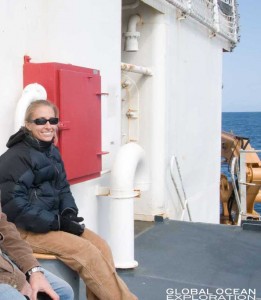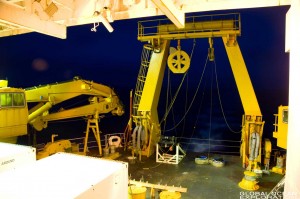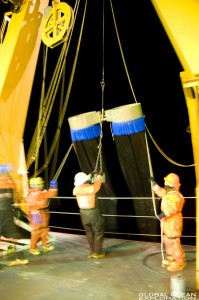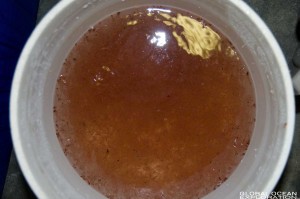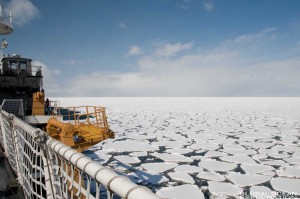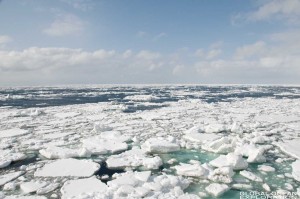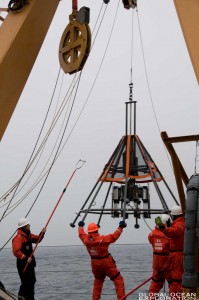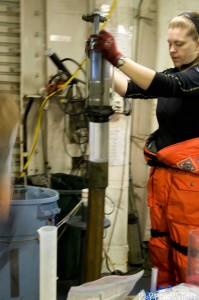Out in the cold and dark early morning the zooplankton ecologists wait for a net tow to come up from the depths in order to collect krill and copepods for their experiments. Once the net comes up, they put the “bugs†into coolers and get ready to go into the cold room to sort them. The cooler is teeming with krill, copepods, Clione (a type of pteropod), amphipods and other varieties of critters. I follow them into the cold room where they divide the plankton and begin sorting through to get the dominant species to run their grazing and other experiments. Dr. Carin Ashjian from the Woods Hole Oceanographic Institution and Dr. Bob Campbell from the University of Rhode Island, with the help of Phil Alatalo and Donna Van Keuren, lead the team which is conducting experiments about the grazing impacts of the mesozooplankton and the fecundity of the animals. Â


“Deploying the ring net used to collect the copepods and krill needed for the team’s experiments”
Â
Their first set of experiments focuses on the grazing of the dominant species of the mesozooplankton, particularly copepods and krill. The mesozooplankton plays a key role in nutrient cycling in the ocean as they provide a key link between the primary producers (phytoplankton) and the larger animals. Their waste settles to the sea floor providing key nutrients for the benthic system. They sort the animals and place individual species into jars with seawater collected from the depth where the animals live. The water is tested for the beginning concentration of chlorophyll which indicates how much food is in the water at the beginning of the experiment. Most mesozooplankton are omnivorous but the team uses chlorophyll to estimate how much of the plant biomass is eaten and to determine the proportion of primary production consumed by mesozooplankton. The jars are then placed in various wraps to emulate the light conditions they would have at depth and they are placed in an incubator of ambient seawater for 24 hours where they rotate and mix constantly.  After this period, the jars are brought to the cold room which is kept at -1 to -1.5 degrees Celsius, where the animals are removed and put into dishes and the water is divided into various bottles for analysis. The water will then be tested for chlorophyll concentration to quantify the changes to biomass. The animals are then dried and packed away to be analyzed for carbon content once back on land along with samples of microzooplankton, phytoplankton and ice algae to determine the food preferences of the bugs.  In this way, Dr. Ashjian, Dr. Campbell, et al are able to quantify the role the mesozooplankton plays in the trophic structure (food web). Â
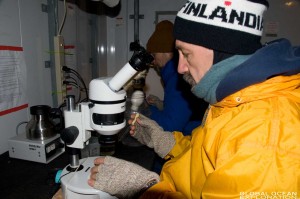
“Phil Alatalo sorts through the sample for animals to use in the experiments”
Â

“Copepods”

“Krill”

“On the bow, the incubators hold the samples for 24 hours in ambient sea water with constant agitation”
Â
Their second experiment is looking at fecundity in females, counting the number of females with eggs, counting eggs and measuring rates of hatching. The females are collected and put into the “bug hotel†which I am told has a total occupancy of 120 copepods and is located in the cold room where they check in for 24 hours at which time their eggs are counted and a sub-sample is taken for the hatching studies. These studies seeks to determine the timing and magnitude of reproduction in relation to what the copepods are eating, is it a function of lipid (fat) reserves, the presence of ice algae or other algal species? These studies can then give the scientists an index of individual growth and food limitations on this growth. Â
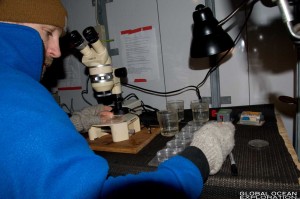
“Dr. Campbell carefully picks female copepods out of a sample to put into the bug hotel for their egg studies”
Â

“Dr. Campbell puts a tray of female copepods into the bug hotel for the egg growth experiment”
Â
The copepod team provides key information to the understanding of a key element of the ecosystem. By sampling in different areas from north to south in the Bering Sea and at various depths and ice coverage, the team is analyzing the effects of the seasonal ice and what could happen if it is not here. Where will the carbon go if the sea warms and there is less ice, to the mesozooplankton or to the benthos (sea floor)? Â

Â
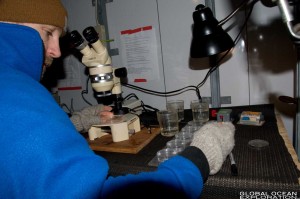
“Dr.Ashjian and Dr. Campbell remove the animals from the experiment jars in order to preserve them for analysis of carbon in the lab. The water is siphoned out for chlorophyll concentration studies.”
Â












